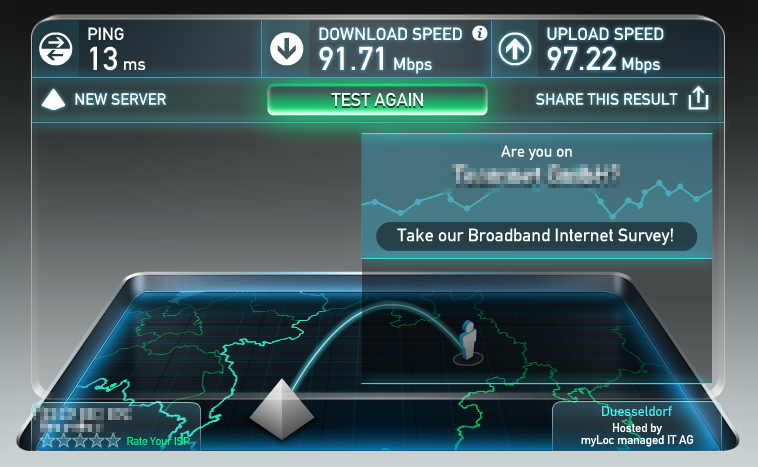Today I saw an USB 3.0 Gigabit Ethernet Adapter at my company and I wanted to know if it’s working on a Sophos UTM. The USB NIC adapter is a Digitus DN-3023 Gigabit Ethernet Adapter (RJ-45 to USB 3.0):
So I installed a new Sophos UTM on a barebone PC. I used an old 9.312-81 software appliance ISO. After the installation and initial setup, I couldn’t see the nic at the linux shell. I found an old Feature Request where a product manager said, that the AX88179 chip will be supported at 9.317:
So i updated the UTM to 9.355-1. After a reboot I still couldn’t choose this adapter in the WebAdmin. So I went to the linux shell to check if the hardware was found:
utm:/root # lsusb
Bus 001 Device 002: ID 045b:0209 Hitachi, Ltd
Bus 002 Device 002: ID 045b:0210 Hitachi, Ltd
Bus 001 Device 001: ID 1d6b:0002 Linux Foundation 2.0 root hub
Bus 002 Device 001: ID 1d6b:0003 Linux Foundation 3.0 root hub
Bus 001 Device 003: ID 058f:9254 Alcor Micro Corp. Hub
Bus 002 Device 003: ID 0b95:1790 ASIX Electronics Corp.
Bus 001 Device 004: ID 03f0:0024 Hewlett-Packard KU-0316 Keyboard
Bus 001 Device 005: ID 046d:c018 Logitech, Inc. Optical Wheel Mouse
Bus 001 Device 006: ID 10d5:55a4 Uni Class Technology Co., Ltd
as you can see, the hardware “ASIX Electronics Corp.” USB NIC adapter was found. OK let’s try to install the hardware as a NIC:
utm:/root # lshw -c network
*-network
description: Ethernet interface
product: RTL8111/8168 PCI Express Gigabit Ethernet controller
vendor: Realtek Semiconductor Co., Ltd.
physical id: 0
bus info: pci@0000:01:00.0
logical name: eth0
version: 06
serial: fc:aa:14:e3:38:49
size: 1Gbit/s
capacity: 1Gbit/s
width: 64 bits
clock: 33MHz
capabilities: pm msi pciexpress msix vpd bus_master cap_list ethernet physical tp mii 10bt 10bt-fd 100bt 100bt-fd 1000bt 1000bt-fd autonegotiation
configuration: autonegotiation=on broadcast=yes driver=r8169 driverversion=2.3LK-NAPI duplex=full firmware=rtl8168e-3_0.0.4 03/27/12 ip=192.168.0.1 latency=0 link=yes multicast=yes port=MII speed=1Gbit/s
resources: irq:105 ioport:e000(size=256) memory:d0704000-d0704fff memory:d0700000-d0703fff
*-network
description: Ethernet interface
product: RTL8111/8168 PCI Express Gigabit Ethernet controller
vendor: Realtek Semiconductor Co., Ltd.
physical id: 0
bus info: pci@0000:02:00.0
logical name: eth1
version: 06
serial: fc:aa:14:e3:38:47
size: 1Gbit/s
capacity: 1Gbit/s
width: 64 bits
clock: 33MHz
capabilities: pm msi pciexpress msix vpd bus_master cap_list ethernet physical tp mii 10bt 10bt-fd 100bt 100bt-fd 1000bt 1000bt-fd autonegotiation
configuration: autonegotiation=on broadcast=yes driver=r8169 driverversion=2.3LK-NAPI duplex=full firmware=rtl8168e-3_0.0.4 03/27/12 ip=10.192.227.96 latency=0 link=yes multicast=yes port=MII speed=1Gbit/s
resources: irq:106 ioport:d000(size=256) memory:d0604000-d0604fff memory:d0600000-d0603fff
*-network DISABLED
description: Ethernet interface
physical id: 1
bus info: usb@2:1.3
logical name: eth2
serial: 00:24:9b:0c:28:76
size: 10Mbit/s
capacity: 1Gbit/s
capabilities: ethernet physical tp mii 10bt 10bt-fd 100bt 100bt-fd 1000bt 1000bt-fd autonegotiation
configuration: autonegotiation=off broadcast=yes driver=ax88179_178a duplex=half link=no multicast=yes port=MII speed=10Mbit/s
the bold text contains the USB NIC adapter information. The device is still disabled. Reboot to activate it. Now you can see the NIC adapter in the WebAdmin:
Ok, but how is the performance of such a NIC? The barebone PC has USB 2.0 and 3.0 ports. I tested both ports and have the same bandwidth results:
The provider delivers an 100Mbit synchronous internet line. So I can say happily that the USB NIC runs very nice! Here are shell commands to check wether the adapter is connected to an USB 2.0 or 3.0 port:
USB 2.0:
utm:/root # lsusb -t
/: Bus 02.Port 1: Dev 1, Class=root_hub, Driver=xhci_hcd/1p, 5000M
|__ Port 1: Dev 2, If 0, Class=hub, Driver=hub/4p, 5000M
/: Bus 01.Port 1: Dev 1, Class=root_hub, Driver=xhci_hcd/6p, 480M
|__ Port 1: Dev 2, If 0, Class=hub, Driver=hub/4p, 480M
|__ Port 3: Dev 3, If 0, Class=vend., Driver=ax88179_178a, 480M
USB 3.0:
utm:/root # lsusb -t
/: Bus 02.Port 1: Dev 1, Class=root_hub, Driver=xhci_hcd/1p, 5000M
|__ Port 1: Dev 2, If 0, Class=hub, Driver=hub/4p, 5000M
|__ Port 3: Dev 3, If 0, Class=vend., Driver=ax88179_178a, 5000M
/: Bus 01.Port 1: Dev 1, Class=root_hub, Driver=xhci_hcd/6p, 480M
|__ Port 1: Dev 2, If 0, Class=hub, Driver=hub/4p, 480M
USB 2.0 has a gross datarate of 480 MBit/Sec (recognizable at “480M” at the end of the line) and USB 3.0 has a gross datarate of 4,000 MBit/Sec (“5000M” at the end of the line).
Currently I’m working for a future project for a tiny UTM. I will use this adapter for this, keep in touch ;-)













12 Responses
Hallo Michel, wiedermal ein spitzen Beitrag ;) Kannst du das mit dem installieren des USB Adapters etwas genauer erläutern. Ich bin in Linux leider nicht so fit möchte das aber an meinem alten HTPC mit 2 Adaptern durchführen.
Danke und weiter so.
Hi Marc,
einfach unter Verwaltung / Systemeinstellung die Shell aktivieren. Lösch “Any” raus und pack nur dein internes LAN rein. Danach downloadest du PuTTY und verbindest dich zu deiner UTM. Log dich erst mit User “loginuser” ein und dann gibst du “su -” ein. Dann das root Passwort. Guck dann mal mit “lsusb” ob der Adapter gefunden wird. Mit “lshw -c network” und “reboot” installierst du diese dann.
hallo kling echt cool, hast du auch die geschwindichkeit intern mit mehr als 100mbit also an 1gbit heran getestet?
da ich auf meinem j1900 board nur einen pci-e steckplatz habe und esxi mit utm 9 und einer nas software laufen lassen will, muss ich 3 netzwerkadapter und ein m1015 raid karte unterbringen, so wäre es möglich
Hi Max,
ne das hatte ich noch nicht getestet. Aber die Karte muss dann dein ESX Server hardwaretechnisch erkennen. Da habe ich leider keine Erfahrungswerte.
Hallo,
danke für den Beitrag!
Bei mir (9.4) hat ein Neustart der Sophos gereicht, und die neue Hardware wurde erkannt. Neues Interface über die GUI hinzugefügt, kein Hack auf der Kommandozeile nötig. Läuft seit 3 Wochen als DMZ ohne Probleme :)
Hallo zusammen,
hat schon jemadn den DELOCK Adapter USB 3.0 Ethernet 2 x RJ45 10/100/1000 getestet ?
Viele Grüße
Hotte
Moin,
ich hab folgenden Adapter genutzt: Ugreen USB 3.0 auf RJ45 Gigabit Ethernet LAN Netzwerkadapter 10/100/1000Mbps
und er funktioniert einwandfrei.
Gruß
Tobi
Hallo.
Wurde denn der Ugreen USB 3.0 auf RJ45 Gigabit Ethernet LAN Netzwerkadapter 10/100/1000Mbps direkt bei der Installation erkannt, oder musstest du den Treiber irgendwie einbinden?
Hi Sebastian,
der sollte direkt sichtbar sein.
Hallo Tobias,
ich habe auch den ugreen 3.0 auf RJ45 (den eckigen) mit dem Chipsatz AX88179. Der Adapter wird an der Sophos erkannt, nur leider bekomme ich darüber kein Netz hin (DHCP requests werden nicht beantwortet) auch mit statischer IP-Adresse bekomme ich keine Verbindung hin. Die LEDs leuchten. Welchen Chipsatz hast du?
Der TP-Link UE300 ist direkt nach einem Reboot verfügbar.